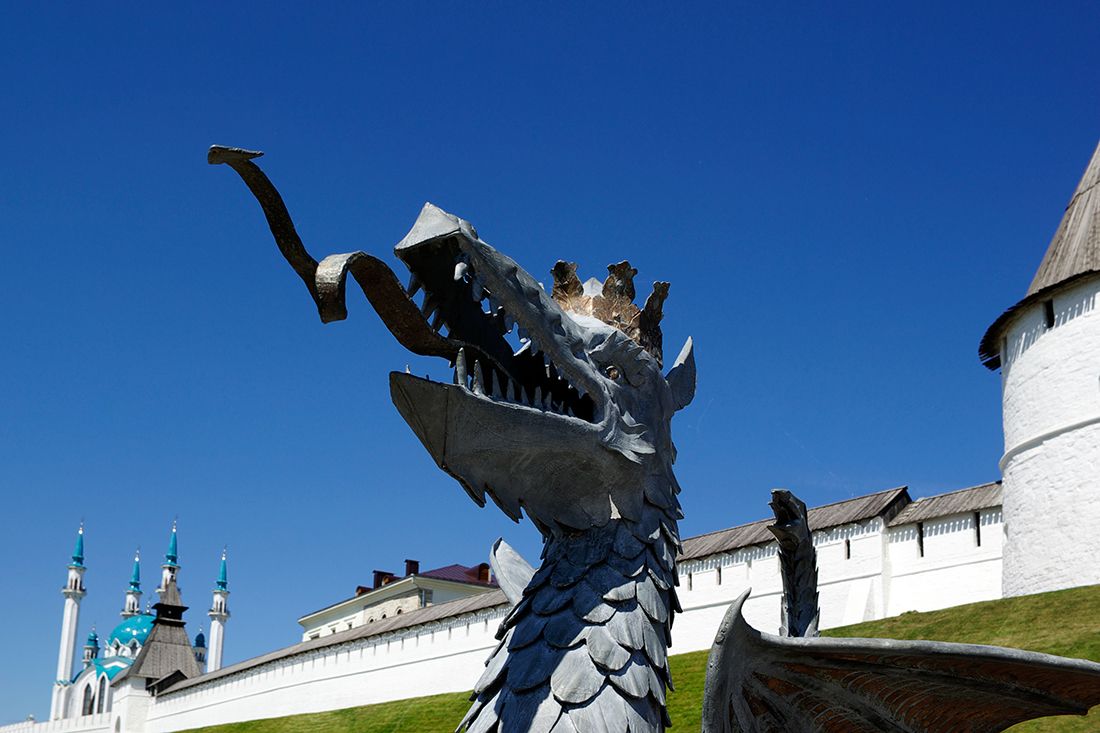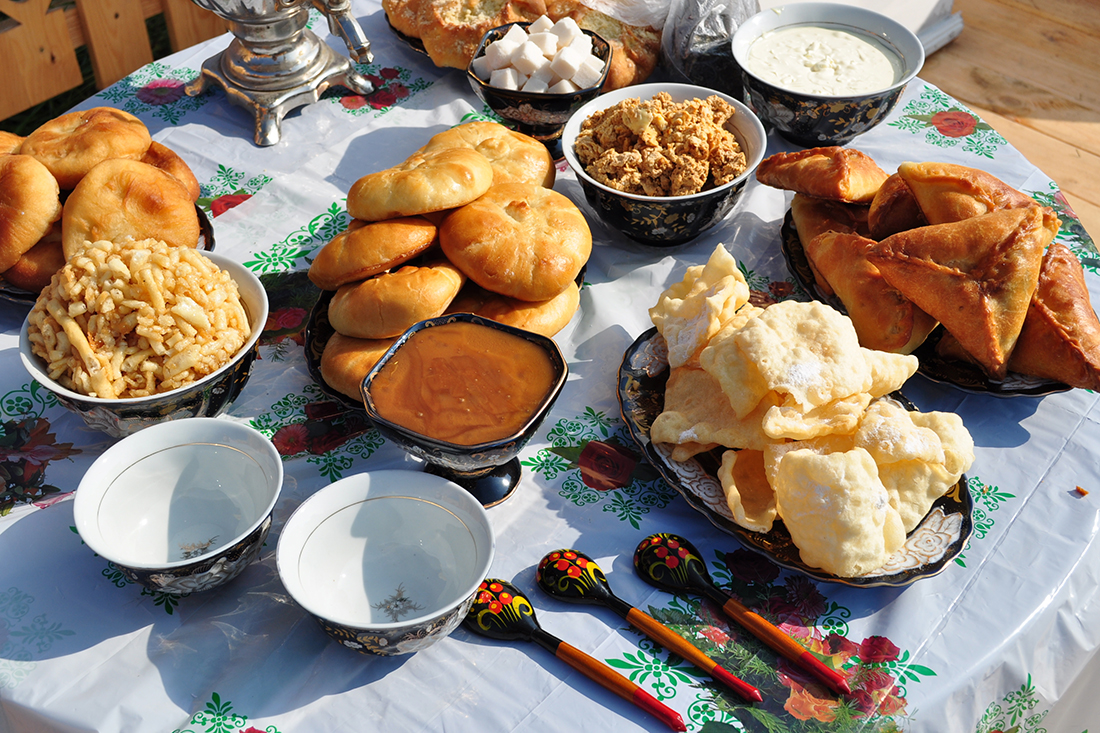
Zylant dragon, the symbol of Kazan, in front of Kazan Kremlin
Alamy/Legion-MediaThe city of Kazan is located on the left bank of the Volga River in the European part of Russia, 800 kilometers to the east of Moscow. A fast-growing city with a population of 1,200,000 people, it is the home of a great variety of nationalities and is famous for its ethnic and religious diversity. In 2005 Kazan celebrated its 1000th anniversary, making it one of the oldest cities in Russia. It is the capital city of the Republic of Tatarstan, one of the major political, social, economic and cultural centers of the Upper Volga region.
Söyembikä Tower, or the Khan’s Mosque, is one of my favorite cultural establishments in Kazan. The tower is considered to be “leaning” just like the tower of Pisa. Its inclination is estimated at almost two meters and lots of tourists take pictures of it as if they were holding the tower in their hands and saving it from falling.
The Qol Åžärif Mosque is also situated in the Kazan Kremlin. It originated in the 16th century and is one of the central monuments for Tatars. The original mosque was destroyed by Ivan the Terrible in 1552 when he conquered the city. The current building is located on the site of its predecessor and was constructed with the donations from 40,000 people. The mosque has four minarets that are 55 meters long and can fit 1,500 people inside and about 10,000 people outside on its grounds. The Qol Åžärif Mosque can be compared to Mecca, as it is a center for thousands of Muslim Tatars who gather here during major Islamic holidays.
 Photo credit: TASS/Stanislav Vasiliev
Photo credit: TASS/Stanislav Vasiliev
The city of Kazan is a homeland for hundreds of nationalities from all over Russia: Tatars, Russians, Chuvashs, Maris, Mordvins, Ukrainians and Jews. All of them live together in peace and mutual respect. Most of Kazan’s population is bilingual, speaking both Russian and Tatar as their native languages. The people of Kazan are very proud of their history and culture and are very hospitable. They are always happy to welcome tourists and foreigners to their native land.
 Photo credit: Lori/Legion-Media
Photo credit: Lori/Legion-Media
Tatar culture has a very strong influence on people’s daily life. An example can be drawn from the national cuisine. The Tatar cuisine is famous for its deserts and pastries with “chak-chak” and “Öçpoçmaq” being the most popular representatives. Chak-chak is a national Tatar desert made of fried dough in the shape of hazelnut-size balls then made in the form of a pyramid and drenched with hot honey. Once ready it can be decorated with nuts and dried fruit. The biggest chak-chak ever was made for the millennium of Kazan in 2005 and it weighed 1,000 kilograms. Öçpoçmaq is a triangular shaped-pastry filled with beef, onion and potatoes. It is usually served with bouillon or tea and can always be found on the table of Tatars during all the major celebrations.
The history of the construction of the Söyembikä Tower is shrouded in mystery. One of the most famous legends postulates that the tower was built in the 16th century when Ivan the Terrible conquered Kazan. According to the legend the Tsar was in love with a beautiful Tatar queen whose name was Söyembikä and he asked her to marry him. Söyembikä did not want to marry the Tsar, so she came up with an impossible condition for marriage hoping the tsar wouldn’t be able to fulfill it. She asked Ivan the Terrible to build a tall tower in seven days so that she could observe Kazan from the top of it and say her final goodbye to her native homeland before departing for Moscow. The Tsar agreed and his architects managed to build the seven-tier-tower on time constructing one tier per day. Söyembikä did not want to marry the evil Tsar who had ruined her homeland, so she threw herself off from the top of the tower. The legend is far from true, but locals love it for both its romantic and tragic nature.
My favorite place is located in the historical heart of Kazan – the Kremlin, Kazan’s citadel. The Kazan Kremlin takes its history back to ancient times when it served as the center for the ancient Bulgar people who had settlements on its territory. Later on the Kremlin served as the residence for the Golden Horde and the Kazan Khanate’s rulers. When Ivan the Terrible conquered Kazan in 1552 he destroyed the citadel and after the surrender of the Kazan Khanate the Tsar ordered the rebuilding of the Kremlin using white stone. Starting in 1552 the Kazan Kremlin became the residence of Russian princes and later governors of the city and the region. The Kremlin today retains its historical role as the political center for Kazan featuring the residence of Tatartan’s President along with other ministerial offices.
Söyembikä Tower, or the Khan’s Mosque, is one of my favorite cultural establishments in Kazan. The tower is considered to be “leaning” just like the tower of Pisa. Its inclination is estimated at almost two meters and lots of tourists take pictures of it as if they were holding the tower in their hands and saving it from falling.
The Qol Şärif Mosque is also situated in the Kazan Kremlin. It originated in the 16th century and is one of the central monuments for Tatars. The original mosque was destroyed by Ivan the Terrible in 1552 when he conquered the city. The current building is located on the site of its predecessor and was constructed with the donations from 40,000 people. The mosque has four minarets that are 55 meters long and can fit 1,500 people inside and about 10,000 people outside on its grounds. The Qol Şärif Mosque can be compared to Mecca, as it is a center for thousands of Muslim Tatars who gather here during major Islamic holidays.
Perhaps the most important holiday here is Kazan’s birthday or City Day celebrated annually on August 30. On this day locals enjoy the warm weather in city parks, walk along the embankment of the Kazan River and Baumanskaya ul. (a large pedestrian street in the heart of Kazan), visit cafes and attend numerous concerts. In the evening the whole city gathers at the Kremlin grounds where a magnificent fireworks display can be observed.
All rights reserved by Rossiyskaya Gazeta.
Subscribe
to our newsletter!
Get the week's best stories straight to your inbox